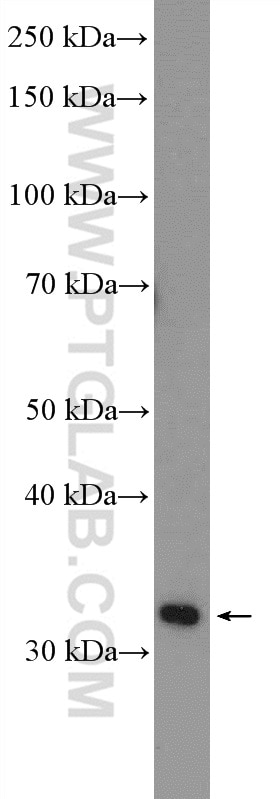Anticorps Polyclonal de lapin anti-LRRC38
LRRC38 Polyclonal Antibody for WB,ELISA
Hôte / Isotype
Lapin / IgG
Réactivité testée
Humain, souris
Applications
WB,ELISA
Conjugaison
Non conjugué
N° de cat : 55479-1-AP
Synonymes
Galerie de données de validation
Applications testées
| Résultats positifs en WB | cellules RAW 264.7 |
Dilution recommandée
| Application | Dilution |
|---|---|
| Western Blot (WB) | WB : 1:200-1:1000 |
| It is recommended that this reagent should be titrated in each testing system to obtain optimal results. | |
| Sample-dependent, check data in validation data gallery | |
Informations sur le produit
55479-1-AP cible LRRC38 dans les applications de WB,ELISA et montre une réactivité avec des échantillons Humain, souris
| Réactivité | Humain, souris |
| Hôte / Isotype | Lapin / IgG |
| Clonalité | Polyclonal |
| Type | Anticorps |
| Immunogène | Peptide |
| Nom complet | leucine rich repeat containing 38 |
| Masse moléculaire calculée | 32 kDa |
| Poids moléculaire observé | 32 kDa |
| Numéro d’acquisition GenBank | XM_001713942 |
| Symbole du gène | LRRC38 |
| Identification du gène (NCBI) | 126755 |
| Conjugaison | Non conjugué |
| Forme | Liquide |
| Méthode de purification | Purification par affinité contre l'antigène |
| Tampon de stockage | PBS avec azoture de sodium à 0,02 % et glycérol à 50 % pH 7,3 |
| Conditions de stockage | Stocker à -20 ℃. L'aliquotage n'est pas nécessaire pour le stockage à -20oC Les 20ul contiennent 0,1% de BSA. |
Informations générales
The large-conductance, calcium- and voltage-activated potassium (BK) channels are characterized by their large conductance of potassium ions (K+) through cell membranes. BK channels are widely expressed with diverse functions in different tissues or cell types, consisting of the pore-forming, voltage- and, calcium-sensing alpha subunits, either alone or in association with regulatory subunits (PMID: 25360119; 22547800). LRRC38 belongs to the gamma family of BK channel accessory subunits that regulate channel gating properties.
Protocole
| Product Specific Protocols | |
|---|---|
| WB protocol for LRRC38 antibody 55479-1-AP | Download protocol |
| Standard Protocols | |
|---|---|
| Click here to view our Standard Protocols |


